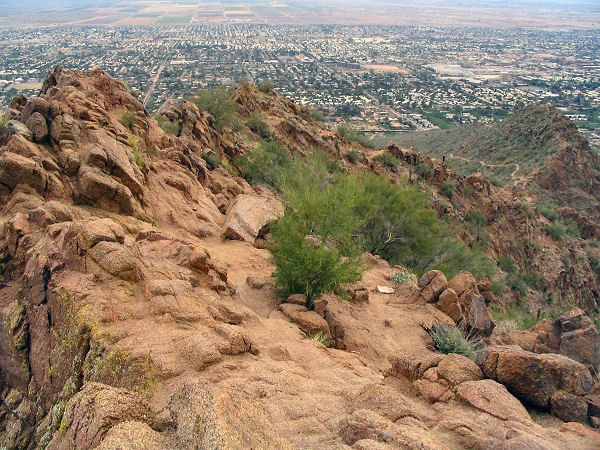We interrupt this biochemistry lesson in order to bring you some personal experiences with ketosis, featuring our special guest, AMPK.
Hey guys, I have a slight change of plans in regards to today's post. I know I said last time that I was going to talk some more about Malonyl-CoA, but in light of recent events (i.e. yesterday: literal hell), I've decided to talk about some of what I experienced, with a generous side helping of biochemistry to go along with it.
As part of the diet plan Dr. Walker has put me and his medical students on, I have to hike Camelback every Friday. For those of you not living in Arizona, it's this thing:
 |
| Geddit, cuz it looks like a camel. |
It's a pretty tough hike, putting it mildly. A lot of it looks like this.
 |
| Eww. |
Anyway, let's get on to some biochem! AMPK is very, very important. It's stimulated by several things: when ATP drops to ADP and then AMP, from the body using ATP as energy by breaking bonds; when calcium builds up in your muscles when they move, through voltage-gated calcium ion channels that make the muscle contract, for those of you who are interested; and from the presence of certain protein kinases. This is why exercise is so important to being healthy, since it stimulates AMPK.
So, what does AMPK do? Remember this scary chart I drew in the last review?
 |
| This one. |
Well, AMPK phosphorylates Acetyl-CoA Carboxylase (ACC), in the way that reduced insulin levels does.
 |
| Yay! |
This way, no Malonyl-CoA is produced, which means no fat is produced. It also allows fat to be mobilized from fat cells to the mitochondria to be burned for energy through beta oxidation, but that'll be saved for the next post.
There's a catch, though. There's a certain concept we call "fat max" that affects the way your body burns fat from exercise that involves your maximum heart rate, which you can approximate by taking the number 220 minus your age. So, since I'm 18, my maximum heart rate should be around 202. Now, when your heart rate gets up this high, your body actually stops burning fat. Let's use another hand-drawn gorgeous graph.
 |
| Excuse the bad handwriting, I don't have my tablet with me. |
Basically, extremely strenuous exercise won't burn as much fat as moderate exercise. Once you pass your fat max point, you start metabolizing glycogen from your liver (which is basically just stored glucose). This glycogen is then restored once you eat more glucose. The catch is to exercise while you're ketotic. Since there is no glycogen in your liver for your body to burn, it
has to get it from fat!
Now, onto ketoadaptation. I mentioned before that I completely ran out of energy while I was exercising. That was because I hadn't fully adjusted to ketosis yet. After the day I had, I think I can say that I am pretty well adjusted to it now.
I said above that I hiked up Camelback, which I did. Then, a few hours later, I had a
three and a half hour belt exam for karate. And it wasn't even a regular exam, oh no. This was a make-up exam, which consisted of about twenty people. Which means all the instructors are focused on you. The whole time.
 |
| Always watching. Smiling at your pain. |
So that was fun. The whole point of this is that, even though I thought I would completely run out of energy and not be able to finish my test after my crazy hike, I was able to push through without getting
too tired. This means that I have almost completely adapted to ketosis, so I should be seeing some of the more positive effects, like increased energy and endurance, soon, so that's something to look forward to!
And I did pass my test, so there's that too.
Next time, I promise I'll talk more about Malonyl-CoA and its role in fat burning. Until then!






No comments:
Post a Comment